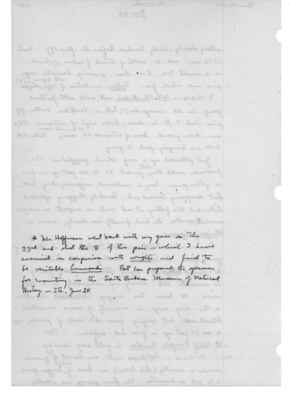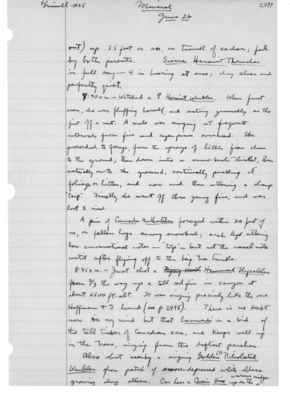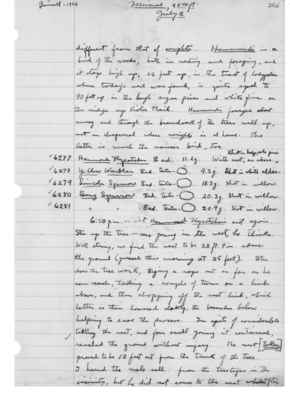Pages That Mention Empidonax hammondii
1925: Joseph Grinnell's field notes
S2 Page 35
Collector: Grinnell - 1925 Location: Unspecified (but presumably either proximate to Mineral or having left for elsewhere). Date: June 24 Page Number: No formal page #.
* Mr. Hoffmann went back with my gun on the 23nd and shot the male of this pair - which I have examined in comparison with wrighti and find to be veritable hammondi. Rett has prepared the specimen for mounting in the Santa Barbara Museum of Natural History - J. G., June 24.
S2 Page 43
Collector: Grinnell - 1925 Location: Mineral Date: June 26 Page Number: 2497
out) up 35 feet or so, on trunk of cedar; fed by both parents. Sierra Hermit Thrushes in full song - 4 in hearing at once, day clear and perfectly quiet.
7:40 a.m. - Watched a [female symbol] Hermit Warbler. When first seen, she was fluffing herself, and attacking generally as tho just off a nest. A male was singing at frequent intervals from fir and sugar pines overhead. She proceeded to forage, from the sprays of little fir close to the ground; then down into a snow-bush thicket, then actually on to the ground, continually picking at foliage or litter, and now and then uttering a sharp "tsip." Finally she went off thru young firs, and was lost to view.
A pair of Canada Nuthatches foraged within 20 feet of us, on fallen logs among snowbush; each kept uttering low conversational notes "Tiys" - but not the nasal note until after flying off to the big tree trunks.
8:45 a.m. - Just shot a Pygmy Nuth Hammond Flycatcher from 2/3 the way up a all red fir in canyon at about 6500 ft. alt. It was singing precisely like the one Hoffmann & I heard (see p. 2495). There is no doubt now in my mind but that hammondi is a bird of the tall timber of Canadian zone, and keeps well up in trees, singing from the loftiest perches.
Also shot a singing Golden ^(?) Pileolated Warbler from batch of snow-depressed white alders growing along the stream. Can hear a Cassin Vireo up on the ^warmer ridge.
S2 Page 62
Collector: Grinnell - 1925 Location: Mineral, 4800 ft. Date: July 2 Page Number: 2515
different from that of wrighti. Hammondi is a bird of the woods, both in nesting and foraging, and it stays high up; 25 feet up, in the tract of lodgepoles where today's nest was found, is quite equal to 90 feet up in the high sugar pines and white firs on the ridge up Viola Trail. Hammondi forages about among and through the branchwork of the trees well up, not in chaparral where wrighti is at home. The latter is much the noisier bird, too.
6277 Hammond Flycatcher [female symbol] ad. 11.2g. With nest, as above. ^Shot in lodgepole pine. 6278 Yellow Warbler [male symbol] ad. testes [testes illustration]. 9.2g. Shot in white alder. 6279 Lincoln Sparrow [male symbol] ad. testes [testes illustration]. 18.3g. Shot in willow. 6280 Song Sparrow [male symbol] ad. testes [testes illustration]. 20.3g. Shot in willow. 6281 [Song] [Sparrow] [male symbol] ad. testes [testes illustration]. 20.4g. Shot in willow.
6:50 p.m. - At Hammond Flycatcher's nest again. Stu up the tree - sees young in the nest, he thinks. With string, we find the nest to be 28 ft. 9 in. above the ground (guessed this morning at 25 feet). Stu does the tree work, tying a rope out as far as he can reach, taking a couple of turns on a limb above, and then chopping off the nest limb, which latter is then lowered slowly, the branches below helping to ease the process. In spite of considerable tilting the nest, and four small young it contained, reached the ground without injury. The nest [taken] proved to be 13 feet out from the trunk of the tree. I heard the male call from the treetops in the vicinity, but he did not come to the nest while after


